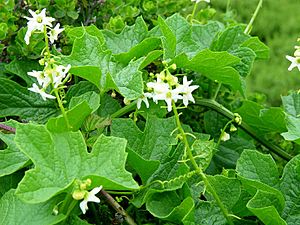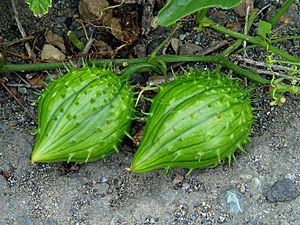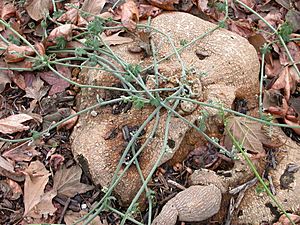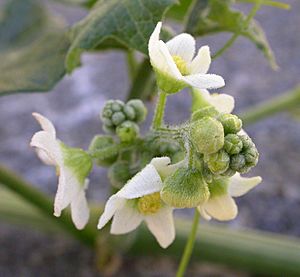Marah (plant) facts for kids
Quick facts for kids Marah (plant) |
|
|---|---|
 |
|
| Marah oreganus (coastal manroot) | |
| Scientific classification |
|
| Kingdom: | Plantae |
| Clade: | Tracheophytes |
| Clade: | Angiosperms |
| Clade: | Eudicots |
| Clade: | Rosids |
| Order: | Cucurbitales |
| Family: | Cucurbitaceae |
| Subfamily: | Cucurbitoideae |
| Tribe: | Sicyoeae |
| Genus: | Marah Kellogg |
| Species | |
|
Marah fabacea |
|
| Synonyms | |
|
Megarrhiza Torr. & A.Gray |
|
Marah plants are also known as manroots, wild cucumbers, or cucumber gourds. They are a type of flowering plant in the gourd family called Cucurbitaceae. These plants grow naturally in western North America. People sometimes call them "Old man in the ground" because of their unique roots.
The name Marah comes from a story in the Bible (Exodus 15:22-25). In this story, "Marah" was a place with bitter water. The scientist Kellogg chose this name because the Marah plants are known for being very bitter.
Most Marah species grow in areas from southern Canada down to northern Mexico. They are usually found within 300 kilometers (about 186 miles) of the Pacific Ocean coast. One species, Marah gilensis (Gila manroot), lives in west-central Arizona. Another, Marah oreganus (coastal manroot), can be found further inland in Idaho.
Contents
About Manroots
What They Look Like
Manroots are perennial plants, which means they live for more than two years. They grow from a very large root that looks like a tuber. Their stems are usually strong and can feel rough or hairy. They have special coiling parts called tendrils. These tendrils help the plants climb up other plants or spread quickly across the ground.
The leaves of Marah plants often have many deep cuts or lobes, sometimes up to seven on one leaf. The fruits are very easy to spot and look quite amazing. They are large and can be round, oval, or shaped like a cylinder. They are at least 3 centimeters (about 1.2 inches) wide, but some can grow up to 20 centimeters (about 8 inches) long. Many species have long spines covering their fruits. The shape of both the leaves and fruits can be very different, even on the same plant.
Their Amazing Roots
The common names "manroot" and "old man" come from the shape of the plant's large root. When you dig up an old plant, its root can look like it has swollen parts and extensions that resemble arms. These roots can grow to be several meters long and weigh more than 100 kilograms (about 220 pounds)!
Types of Manroots


Marah species can hybridize (mix their features) easily when they grow in the same areas. This, along with how much the leaves and fruits can change, makes it hard to identify exactly which species a plant is.
Scientists usually group Marah plants based on how they look and where they grow. There are about six or seven different species, and some of these have smaller groups called varieties. Here are some of the main species:
- Marah fabacea – California manroot
- Marah fabacea var. agrestis
- Marah fabacea var. fabacea
- Marah gilensis – Gila manroot
- Marah guadalupensis – often grouped with M. macrocarpus var. major
- Marah horridus – Sierra manroot
- Marah macrocarpa – Cucamonga manroot
- Marah macrocarpa var. macrocarpa
- Marah macrocarpa var. major
- Marah macrocarpa var. micrantha
- Marah oreganus – coastal manroot
- Marah watsonii – Taw manroot
How People Used Manroots
Traditional Uses by Native Americans
Native American tribes used Marah oreganus for medicine. For example, the Chinook people made a soft paste from the gourd to put on injuries. The Squaxin people would mash the upper part of the stalk in water and dip their aching hands into it. The Chehalis tribe burned the root and mixed the ash with bear grease to put on skin sores. The Coast Salish people made a special liquid to help with kidney problems.
Other Uses
The spiky fruit of the manroot can be soaked in water. This makes the spikes soft and easy to remove. Once the spikes are gone, the fruit itself becomes soft. It can then be used like a natural loofa sponge for washing.
The large roots of M. fabaceus and M. macrocarpus contain natural chemicals called saponins. These saponins can create a lather, so they were used as a natural soap.
The Kumeyaay people would crush the roots of M. fabaceus and throw them into water. The saponins in the roots would affect fish, causing them to float to the surface. This made it easier to catch the fish.
Important Safety Note
Like many plants used for traditional medicine, some Marah species are poisonous if eaten. There have been reports of people getting very sick or even dying from eating parts of these plants. It is very important to remember that you should never eat any wild plants without guidance from a knowledgeable adult.
See also
 In Spanish: Marah para niños
In Spanish: Marah para niños


